The recently completed new Hong Kong Convention and Exhibition Centre (HKCEC) Atrium Extension secures the city’s future as arguably the MICE (meetings, incentives, conventions and exhibitions) capital of Asia. The extension set massive construction records whilst providing a huge boost to the local economy.
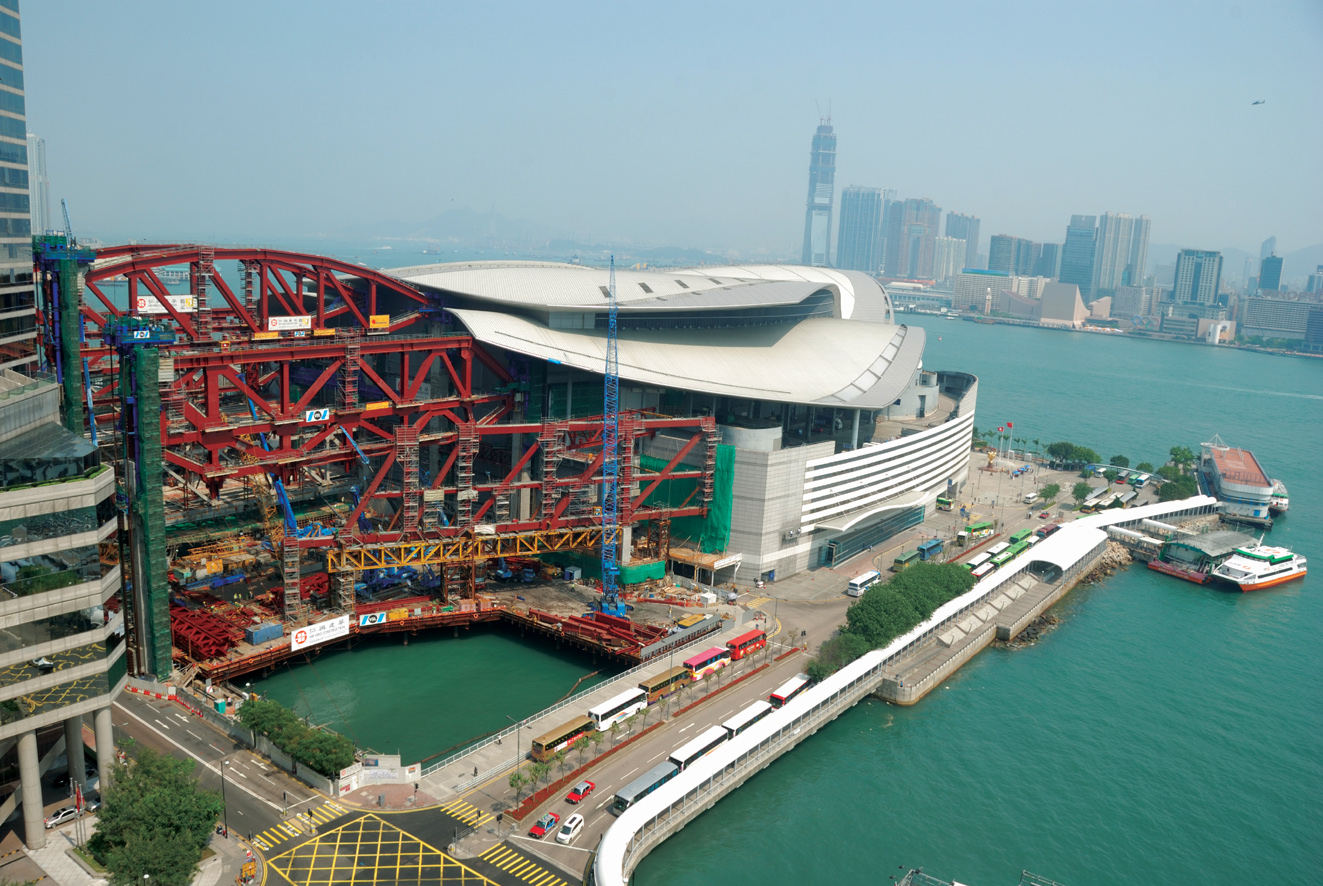 Commenced in May 2006 and completed in April 2009, work on the project was finished in a record-breaking 34 months. Designed by Wong and Ouyang (HK) Ltd., the HKCEC extension was constructed by Hip Hing and Ngo Kee Joint Venture and has been built over a site area of 8,500 square metres, increasing exhibition halls capacity from 46,608 square metres to 66,608 square metres. During the construction period, 2,000 personnel worked on-site each day.
Commenced in May 2006 and completed in April 2009, work on the project was finished in a record-breaking 34 months. Designed by Wong and Ouyang (HK) Ltd., the HKCEC extension was constructed by Hip Hing and Ngo Kee Joint Venture and has been built over a site area of 8,500 square metres, increasing exhibition halls capacity from 46,608 square metres to 66,608 square metres. During the construction period, 2,000 personnel worked on-site each day.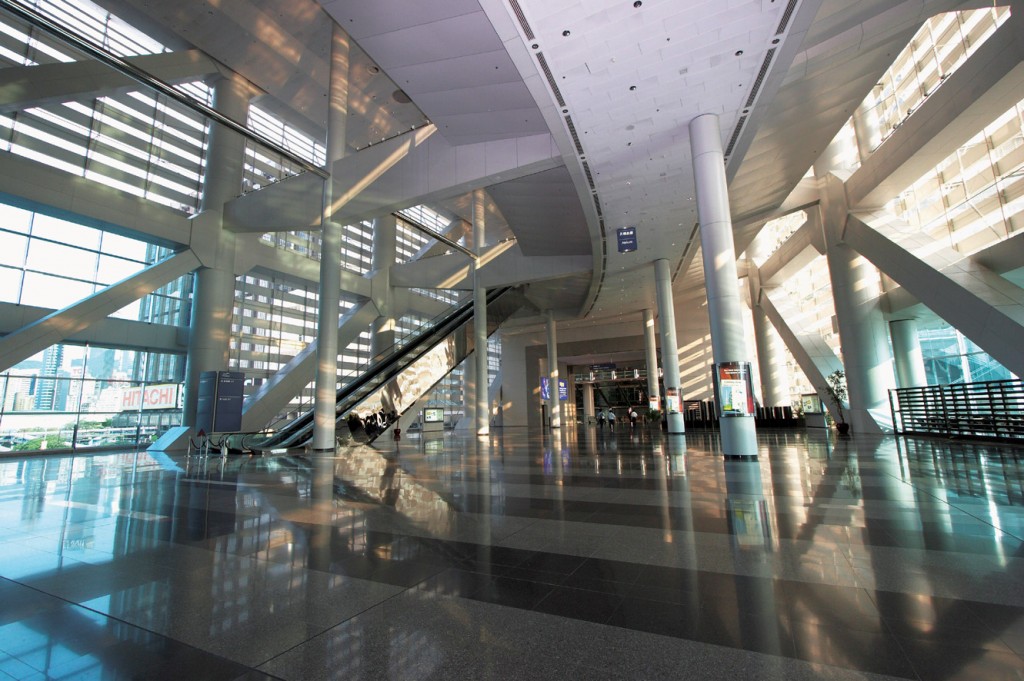
“The HKCEC expansion marks a new era for conferences and exhibitions,” said Hong Kong Trade Development Council (HKTDC) Executive Director Fred Lam. “Hong Kong will become a world leader in the scale of its trade fairs. We believe that there will be many more trade shows at the HKCEC in the future, attracting more international buyers and bringing substantial benefits to Hong Kong,” he said.
The new HKCEC extension has expanded the three levels of exhibition halls into the airspace above the water channel linking HKCEC Phases I and II and adds a massive 42 per cent more exhibition space (19,400 square metres) that will accommodate about 1,000 standard exhibition booths.
Funded by Hong Kong Trade Development Council (HKTDC) and built at a cost of HK$1.4 billion, the expansion also broke several construction records in the process:
- Used the heaviest crane in building construction history
- Construction took place from top to bottom, reversing traditional building techniques
- Used the largest metallic bearing in building construction
- Used the heaviest steel truss in building construction history
- In comparison with other construction projects in Hong Kong, the HKCEC expansion used more heavy-duty cranes, even borrowing two heavy-duty cranes from Shanghai and Tianjin able to lift 500 tonnes and 400 tonnes respectively.
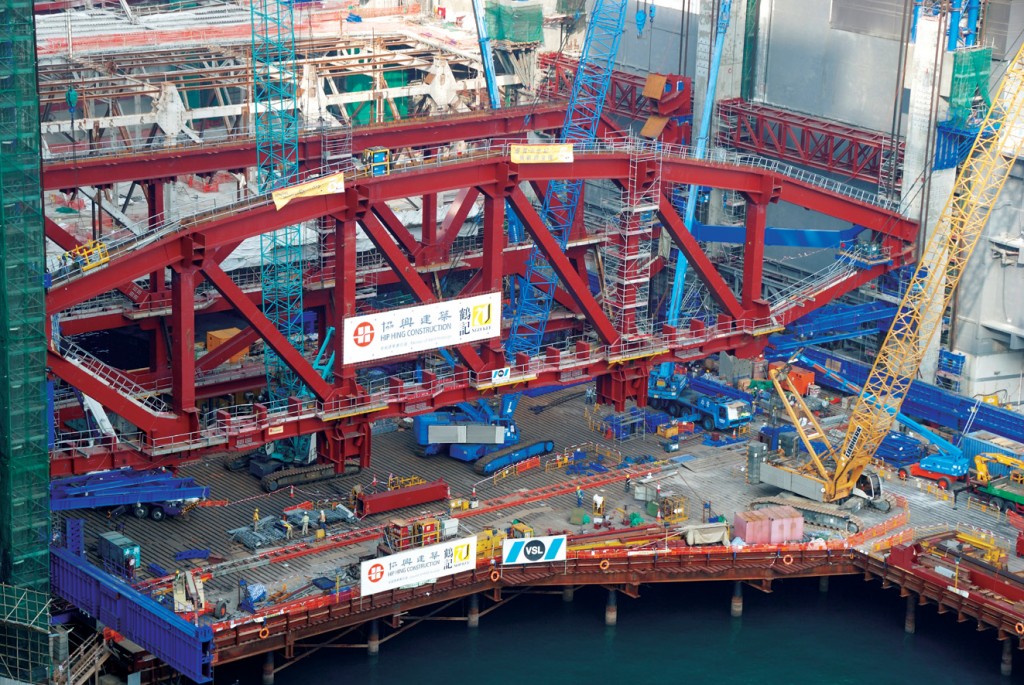 The project utilised bridge construction methods, with the biggest bearing 2.83 metres in diameter and bearings supporting as much as 19,200 ton. The extension was also the heaviest lifting operation conducted on a building project, whilst the 3.1 metre bored pile was the largest of its kind and the primary steel truss structure was the heaviest ever used in a building project at 109-metres long spanning across the sea channel between Phases 1 and II.
The project utilised bridge construction methods, with the biggest bearing 2.83 metres in diameter and bearings supporting as much as 19,200 ton. The extension was also the heaviest lifting operation conducted on a building project, whilst the 3.1 metre bored pile was the largest of its kind and the primary steel truss structure was the heaviest ever used in a building project at 109-metres long spanning across the sea channel between Phases 1 and II.
Effective and environmentally conscious green design solutions have also incorporated into the new HKCEC extension. The landscaped roof maximises the use of natural lighting, while the green roof enhances the environment and reduces heat gain, a point not lost on both residents and visitors to Hong Kong during the hot summer months. Low-emission glass utilised in the curtain wall also reduces heat gain and glare. 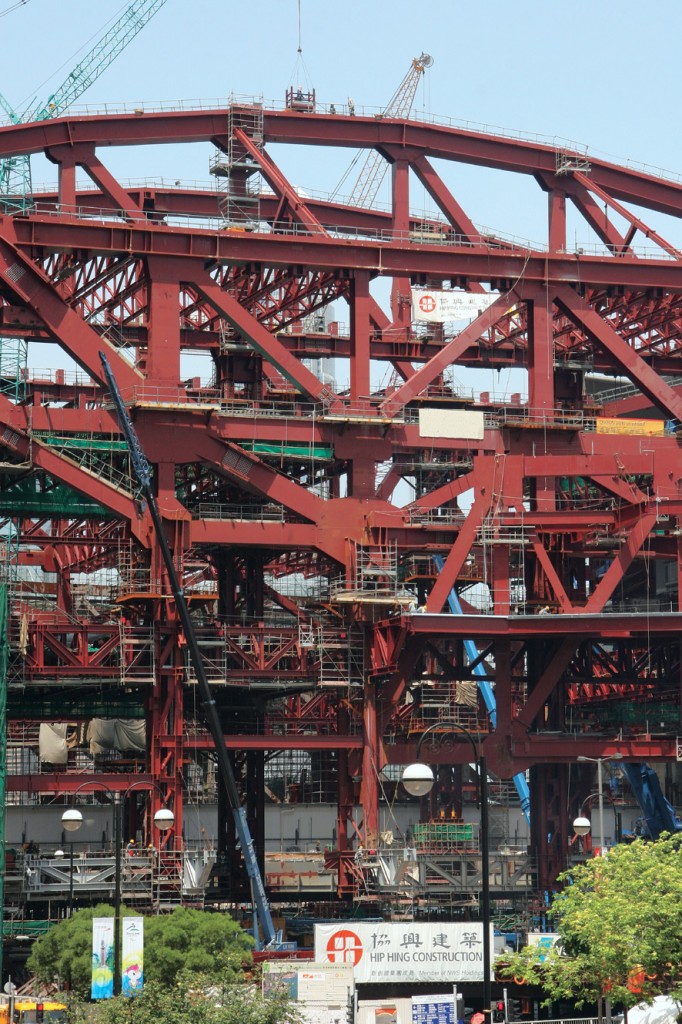
Additional environmentally friendly design components include daylight sensors to turn off lights, energy-efficient lamps, variable speed controls in escalators including a standby mode when not in use and the use of variable-speed-drive motors in water pumps to reduce energy consumption. An energy-efficient air-conditioning system has also been installed, with the heat recovery system using exhaust air to pre-cool supply air, while a Variable Air Volume (VAV) system controls air temperature by varying the amount of cool air supply. The system also used spare capacity in the existing air-conditioning system to reduce additional new plant. The result is a saving of 12 per cent in overall electricity consumption.
Water consumption will also be greatly reduced, with water collected from air-conditioning condensation used for general cleaning and irrigation purposes, while recycled seawater from air-conditioning cooling will be used for flushing. Other environmentally friendly aspects of the new extension have seen escalators from the original Atrium Link being reused and the original floor slab retained to reduce construction waste.
By way of comparison, the surface area of HKCEC’s exhibition hall 1 now totals 20,000 square metres or the equivalent of two football fields and during construction, the maximum load lifted was 4,000 tonnes or the equivalent of 22 Boeing 747s.
The bearings used in the HKCEC construction were 2,830 millimetres across, as compared to the bearings used for the Tsing Ma Bridge which are only 750 millimetres in diameter. The project also used five 109-metre steel trusses that span the banks of the channel, with each steel truss climbing 10 metres to 26 metres in height and weighing between 1,700 tonnes and 2,100 tonnes.
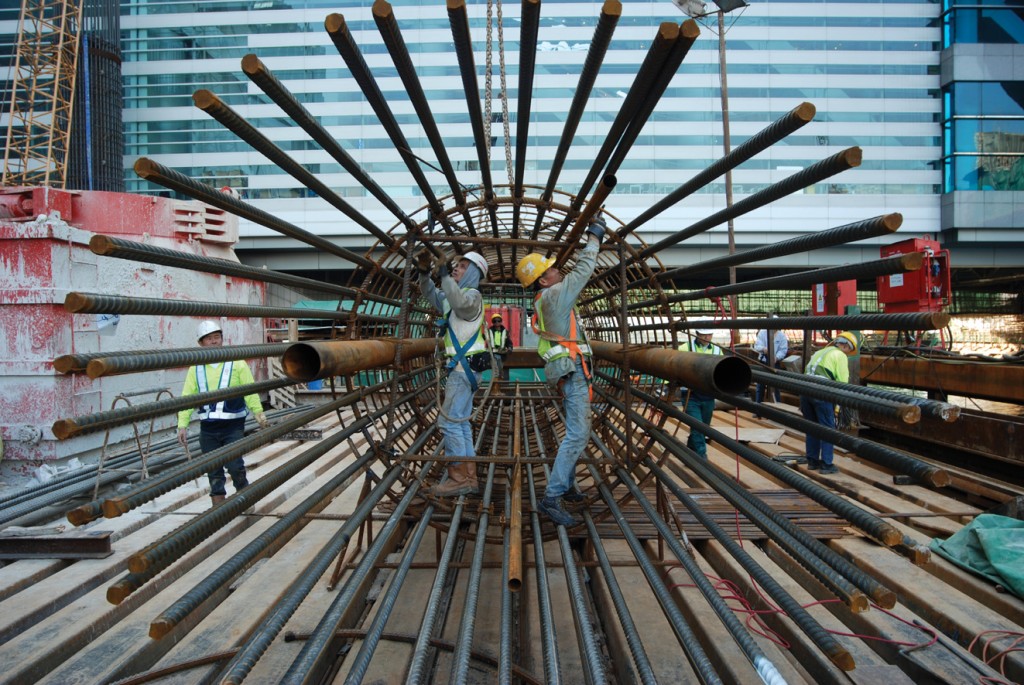 The total project also used 28,000 tonnes of iron in comparison to the International Commerce Centre currently under construction, which is only expected to use 32,000 tonnes. Another very Hong Kong-related construction industry fact is that if all the bamboo scaffolding used in the project was placed end-to-end, it would total 10,000 kilometres in length or the equivalent to the distance between Hong Kong and Vancouver, British Columbia.
The total project also used 28,000 tonnes of iron in comparison to the International Commerce Centre currently under construction, which is only expected to use 32,000 tonnes. Another very Hong Kong-related construction industry fact is that if all the bamboo scaffolding used in the project was placed end-to-end, it would total 10,000 kilometres in length or the equivalent to the distance between Hong Kong and Vancouver, British Columbia.
It is expected that the cumulative economic benefits from the HKCEC expansion will amount to HK$40 billion, with up to 92,000 new jobs created between 2009 and 2025. “The exhibition business is a major pillar of the Hong Kong economy, contributing 6.4 per cent of its GDP and 6.5 per cent of its employment,” stated Mr Lam.
Hong Kong’s trade fair and exhibition sector had an estimated direct, indirect and induced economic impact of HK$45.5 billion in revenue, HK$28.9 billion in value added and 95,000 jobs in 2007. In addition, the impact on value added associated with the generation or facilitation of exports was estimated at HK$74 billion. The employment impact of this was projected at 130,000 jobs in 2007.
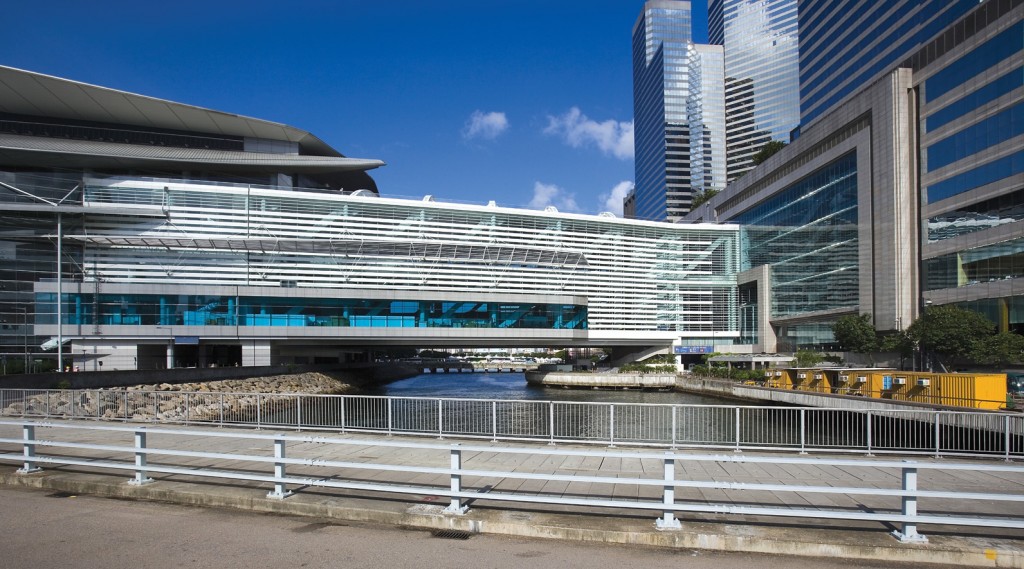 Mr Lam pointed out that HKTDC organises more than 30 trade fairs a year, eight of which are the largest of their kind in Asia. “These are among the must-attend events in the world’s sourcing calendar. The completion of the expansion will give them, and other fairs, space to grow, enabling some to become among the World’s largest,” he said. “But we will need to explore long-term solutions in order to maintain Hong Kong’s status as Asia’s trade-fair capital. I sincerely appreciate the behind-the-scenes work that allowed the impossible to become possible, creating new business opportunities for local SMEs,” Mr Lam added, emphasising that the HKCEC expansion was completed on time, despite many challenges.
Mr Lam pointed out that HKTDC organises more than 30 trade fairs a year, eight of which are the largest of their kind in Asia. “These are among the must-attend events in the world’s sourcing calendar. The completion of the expansion will give them, and other fairs, space to grow, enabling some to become among the World’s largest,” he said. “But we will need to explore long-term solutions in order to maintain Hong Kong’s status as Asia’s trade-fair capital. I sincerely appreciate the behind-the-scenes work that allowed the impossible to become possible, creating new business opportunities for local SMEs,” Mr Lam added, emphasising that the HKCEC expansion was completed on time, despite many challenges.
About 20 new trade fairs will take place at the HKCEC in the coming year. They will cover a wide range of industries and sectors, including: baby products, financial services, the funeral business, home textiles, lifestyle products, lighting, medical equipment, retail technology and tea. In addition, 30 recurrent fairs will use the new exhibition halls in the HKCEC expansion.













